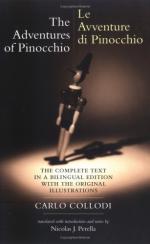|
This section contains 174 words (approx. 1 page at 300 words per page) |

|
SOURCE: "A Juvenile Classic," in The New York Times Book Review, April 3, 1909, p. 192.
In the following review, the critic examines the moral teachings of Pinocchio.
Among the illustrious collection of illustrated books "every child should know," the Italian juvenile classic, The Marvellous Adventures of Pinocchio, by Carlo Lorenzini, is entitled to a place; if not a first place, at least one very near the top. . . .
The story of Pinocchio is an allegory, a guide to self-control, self-government, and self-determination in children. Its concise style and picture words are well calculated to hold the attention of children. A few scenes in the book, however, might be considered too gruesome for the child mind—such as the description of the young girl who died and was waiting for the hearse to come and carry her away. But the moral of the puppet who, by overcoming his evil influences and following...
|
This section contains 174 words (approx. 1 page at 300 words per page) |

|


